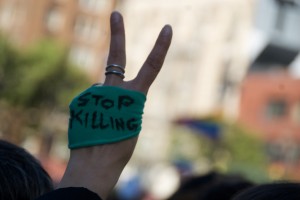After two years in the U.S. Jasmine was diagnosed with post-traumatic stress disorder, or PTSD. Now she's getting counseling at Centers for Survivors of Torture (CST) in San Jose. But Jasmine said most of her Iraqi peers shy away from treatment because Iraqi culture, like many others, often considers mental health problems shameful.
Jasmine said therapy has given her tools to help her avoid reliving traumatic moments -- a common symptom of PTSD. She says even though she can’t forget her past, she is learning how to deal with it through various activities, like doing crafts. "Especially like when I’m over-thinking I go to crochet," she said.
Though many Middle Eastern refugees are Iraqis who have fled war-related violence, in the past decade the largest number of Middle Eastern refugees in California are actually from Iran. More than 15,000 Iranian refugees have moved to California since 2006. Many Iranians suffer religious and political persecution. And they face many of the same social and cultural taboos about seeking mental health care as Iraqi refugees.
Azin Izadifar, a 45-year-old Iranian refugee, came to the U.S. in 2009 seeking asylum. She had been arrested for participating in secret meetings during Iran’s 1979 revolution, and spent the next three years being tortured in Iran’s notorious Evin Prison. She continued to have run-ins with the Iranian government after her release, so she eventually sought asylum in the U.S. She said even though she was in America and felt safe, life was difficult. She said her nightmares about her time in Evin Prison followed her to San Jose.
“It had become so normal for me that I couldn't even understand that there was a problem there –- I had a sleep disorder. And it could be related to the trauma I had in prison,” said Izadifar. "Then I realize, 'OK, that's a sign of PTSD.'"
Izadifar eventually saw a therapist and was indeed diagnosed with PTSD. She said she sees the same PTSD symptoms in many newly arrived Iranian refugees -- even among people who were never imprisoned. But most of them, she said, aren’t seeking therapy.
“There’s a tendency in our culture to underestimate that and say, ‘Okay, that was past. Now we are in a free society. We have to live our lives. We have to buy a car and get a job and just be normal.'”
Izadifar and Jasmine are not alone. Most refugees have been exposed to violence and trauma unheard of in the west. In the U.S., seeing a counselor is more widely accepted, but many in the refugee community would never think that way, said Sally Sharrock, a former therapist with Centers for Survivors of Torture. She said refugees more likely to go to first ask a family member or a physician for help.
As part of a federal refugee package, people are entitled to medical and mental health care. Sharrock’s job was to get people into counseling and to keep them coming back after their first session. She said her sessions often began with practical support. “A lot of people are really actually more interested in being able to find a job and support their family and find good housing before they’re ready for any kind of psychological supportive services or therapy.”
To keep refugees coming back, Sharrock said she avoided using terms that might be associated with a mental illness, like “depression,” or “anxiety.” She said she’s found that one term seems to work across the board -- "stress."
“Often times we find the word 'stress' works for people,” Sharrock said. “I may then ask them how they’ve been affected by stress, how they’ve been coping with it in their own culture up until now. And our conversation will kind of progress from there.”
Izadifar, the Iranian refugee, said the therapy at CST helped her finds tools to work through her healing process. She said she's now writing a memoir as a form of therapy. Izadifar said it's not hard to pull up those memories, because the wounds of trauma never fully disappear.
